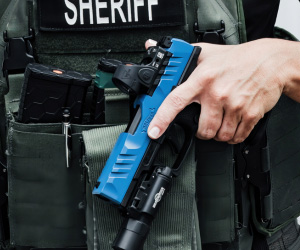
Faster mastery. Smarter budgets. Safer officers.
Duty pistols are changing. As agencies add pistol-mounted optics (PMOs) to patrol and special-unit pistols, training and qualification must evolve with them. Below is a practical, agency-ready approach that pairs policy, a simple training progression, and a cost model to help stretch training dollars without sacrificing realism or safety.
Why Red-Dot Optics Matter in Police Qualification
Red-dot sights simplify aiming by putting the focal point on one plane — the dot — instead of juggling front sight, rear sight and target. That speeds sight acquisition, helps officers with aging eyes, and improves consistency under stress. National training programs and industry voices now emphasize optics as part of an integrated policy → training → qualification plan.
Start with policy — then train to it
Rollouts that begin with a clear policy run smoother. Your policy should:
- Approve specific optics and mount types.
- Define zero procedures and frequency of checks.
- Specify holsters, backup sights, and maintenance cycles.
Once policy is set, align instructor development and lesson plans to that policy so squads receive consistent coaching and standards.
Train instructors early
Instructor consistency is critical. Short, focused instructor courses that cover optics fundamentals, troubleshooting, and teaching methods keep transitions predictable and auditable across the agency.
A simple progression: Crawl → Walk → Run
A staged progression builds skill and preserves live ammo while keeping reps high.
Crawl — dry runs & marker drills
- Safe, high-rep work using dry-fire and marker platforms.
- Teach “find the dot” from the holster, brightness management, occlusion methods, and administrative handling with optics installed.
- Builds fundamentals before adding recoil and movement.
Walk — force-on-force & movement
- Add movement, use of cover, step-outs and thresholding.
- Train occluded-optic methods while maintaining target focus and processing speed.
- Instructors verify consistency across teams.
Run — live-fire confirmation & qual
- Confirm zero, validate dot tracking under recoil, and run agency qualification standards at speed.
- Include a failure/occlusion stage (dot off or occluded) and complete debriefs and documentation.
Why use a T4E Walther PDP for familiarization
Before live fire, officers need realistic hands-on time. The T4E Walther PDP:
- Accepts pistol optics and mirrors duty handling.
- Runs on 12-gram CO₂ and fires .43-caliber rubber or powder rounds for safe, realistic drills.
- Supports high-volume draw-to-dot, tracking, and manipulation drills in gyms, houses, or shoot houses (with proper PPE and SOPs).
Because marker platforms allow large numbers of safe repetitions, departments can focus live ammo on validation and qualification.
Practical training blocks for qualification prep
Use compact, repeatable blocks that map straight to qual expectations.
Block A — Presentation & Dot Acquisition (marker)
Objectives: Present to a visible dot on an 8-inch target, hold the dot through press-out, and practice brightness adjustments in varying light.
Block B — Movement, Cover & Occlusion (marker)
Objectives: Step-outs, lateral movement, use of cover, and working occluded-optic methods. Validate low-light performance with controlled brightness.
Block C — Live Fire & Qualification
Objectives: Confirm zero, track the dot under recoil, meet agency time/accuracy standards, and run a “dot-off” failure stage. Record results and debrief.
This block structure aligns with national optics-training guidance and instructor curricula.
Cost-Effective Police Training with CO2 Marker Platforms
Marker platforms let you capture high counts of early reps and reserve 9mm for final confirmation — a strategy that stretches budgets.
Example assumptions (use your contracted prices to refine):
- 9mm training ammo ≈ $0.15/round
- T4E rubberball + CO₂ ≈ $0.10/shot
- Per-shot savings ≈ $0.05
Using a T4E Walther PDP at an assumed street price of $269.99, the simple break-even is roughly 5,400 marker shots. After that point, every drill run on the T4E platform yields per-shot savings versus live 9mm. Replace these example figures with your contract pricing and track usage to show real savings over time.
How to Increase Safety and Realism through Training
- Always use full PPE and strict scenario controls.
- Segregate live weapons during marker training.
- Use approved backstops for rubber/powder loads.
- Document lesson plans, safety briefs, and after-action reviews.
What to measure during qualification
Create measurable standards that reflect optic use:
- Regular zero checks at defined distances.
- Dot tracking and retention during recoil.
- Performance under movement and with cover.
- Brightness control in low light and mitigation for fogged or powered-down optics.
- Maintenance logs for batteries and mounts.
Logging these metrics makes training auditable and defensible.
What are the Key Takeaways to Run Optic-Ready Training for Law Enforcement with T4E Training Tools
Pistol-mounted optics are rapidly becoming standard on duty pistols. Agencies that plan the rollout — policy first, instructor development, then a crawl/walk/run training progression that uses marker familiarization followed by live-fire confirmation — achieve faster adoption, better proficiency, and smarter use of training dollars. T4E platforms provide realistic, cost-effective familiarization that keeps reps high and live-fire focused on validation.
References & further reading
- Federal Law Enforcement Training Centers — Handgun Optic Training Program.
- POLICE Magazine — Writing a Handgun Optics Policy.
- Police1 — Red dot sights on pistols for patrol officers: Policy and training considerations.
- National Law Enforcement Firearms Instructors Association — Red Dot Sights for Duty Pistols.
- ANSgear / Natchez product pages — T4E Walther PDP marker listings.
- Ammo.com — 9mm pricing context.
